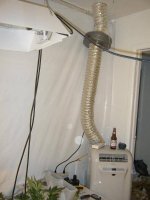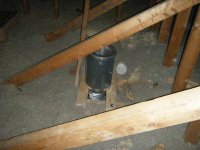Its not every day that i learn something new, but i met a fine gentleman today that is an overly experienced hvac tech. He taught me some solid info, so i will share it with you. Ive learned so much here, this is the least i can do.
#1... If you vent into your chimney.....
Air pressure in a chimney is always negative pressure. If you vent into it, you are creating positive pressure. This creates an "air curtain" over your hot water vent and your furnace vent which are both tapped into the chimney of your house at the basement or first floor level. What happens now is, the positive pressure you are applying now restricts/blocks the flow of the carbon monoxide from your heater and hot water heater, and can force it to backflow into the room!!!!!! There is a fix to this, but i dont understand it well enough yet to say. I think it has to do with dropping a pipe down your chimney and hooking it up to the vents that are being restricted. I will update this one when i have a better understanding.
#2... For all people who use a/c or dehumidifer water for their plants...
Make sure that the coil in your appliance is NOT COPPER!! The condensation contains traces of copper and can/will poison your plants.
#3.... AC UNITS... He said the only a/c units that dont leak out smell or c02 are the mini splits. Everything else does, at least according to him. I even specifically asked if the portable dual hose units did this, and he said yes.
#4... 6" flex duct is only capable of moving about 90cfm.... That just sounds like a minute amount of movement tho...
#5...He had a simple formula for figuring out how many btu's lights put out!! Heres the numbers, but i just rounded them since they were so close.
1000watt open= 3000btu
1000watt air cooled= 2000btu
600watt open= 2000btu
600watt air cooled=1200btu
Those are just the rough numbers from what i remember, but i will update them once i ask him again, those are close tho. Also, the air cooled numbers are only if the lights are setup and cooled in an efficient way.
#6.. Its always best to run the next size up ducting as to what your fan accepts. I.E. If you have a 8in. fan, use 10 in. duct in order to get the max cfm's out of your fan.
#7 Rigid duct can move almost twice as much air as flex. It makes no sense to have 6" in flex duct installed and then use rigid duct further down the line.
I just met this guy today, but he is cool and he REALLY knows his shit. He actually teaches duct design and installation classes. I was rather stoned when i learned all this info, so some of this may be a tad squewed but i will fix it once i get the solid idea of some of this stuff. thx for listening.
#1... If you vent into your chimney.....
Air pressure in a chimney is always negative pressure. If you vent into it, you are creating positive pressure. This creates an "air curtain" over your hot water vent and your furnace vent which are both tapped into the chimney of your house at the basement or first floor level. What happens now is, the positive pressure you are applying now restricts/blocks the flow of the carbon monoxide from your heater and hot water heater, and can force it to backflow into the room!!!!!! There is a fix to this, but i dont understand it well enough yet to say. I think it has to do with dropping a pipe down your chimney and hooking it up to the vents that are being restricted. I will update this one when i have a better understanding.
#2... For all people who use a/c or dehumidifer water for their plants...
Make sure that the coil in your appliance is NOT COPPER!! The condensation contains traces of copper and can/will poison your plants.
#3.... AC UNITS... He said the only a/c units that dont leak out smell or c02 are the mini splits. Everything else does, at least according to him. I even specifically asked if the portable dual hose units did this, and he said yes.
#4... 6" flex duct is only capable of moving about 90cfm.... That just sounds like a minute amount of movement tho...
#5...He had a simple formula for figuring out how many btu's lights put out!! Heres the numbers, but i just rounded them since they were so close.
1000watt open= 3000btu
1000watt air cooled= 2000btu
600watt open= 2000btu
600watt air cooled=1200btu
Those are just the rough numbers from what i remember, but i will update them once i ask him again, those are close tho. Also, the air cooled numbers are only if the lights are setup and cooled in an efficient way.
#6.. Its always best to run the next size up ducting as to what your fan accepts. I.E. If you have a 8in. fan, use 10 in. duct in order to get the max cfm's out of your fan.
#7 Rigid duct can move almost twice as much air as flex. It makes no sense to have 6" in flex duct installed and then use rigid duct further down the line.
I just met this guy today, but he is cool and he REALLY knows his shit. He actually teaches duct design and installation classes. I was rather stoned when i learned all this info, so some of this may be a tad squewed but i will fix it once i get the solid idea of some of this stuff. thx for listening.




 he was prolly talkin in the portable scene when it comes to ac tho.
he was prolly talkin in the portable scene when it comes to ac tho.
